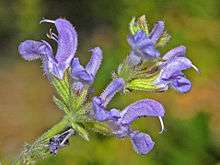Salvia virgata
Salvia virgata (wand sage, southern meadow sage) is a perennial plant that is native to Asia and southeastern Europe. It is considered a noxious weed in many parts of the world.[1]
| Salvia virgata | |
|---|---|
 | |
| Flower of Salvia virgata at the Orto Botanico di Brera | |
| Scientific classification | |
| Kingdom: | Plantae |
| Clade: | Tracheophytes |
| Clade: | Angiosperms |
| Clade: | Eudicots |
| Clade: | Asterids |
| Order: | Lamiales |
| Family: | Lamiaceae |
| Genus: | Salvia |
| Species: | S. virgata |
| Binomial name | |
| Salvia virgata | |
S. virgata is sometimes included within Salvia pratensis. Flowers grow in whorls of 4–6 with a blue-violet corolla (rarely white) that is 1 to 2 centimetres (0.39 to 0.79 in) long. The ovate to oblong leaves are dull green on the top surface, with the underside covered with glands and thick hairs.[2]
Notes
- "Salvia virgata". Germplasm Resources Information Network (GRIN). Agricultural Research Service (ARS), United States Department of Agriculture (USDA). Retrieved 13 March 2012.
- DiTomaso, Joseph M.; Healy, Evelyn A. (2007). WEEDS OF CALIFORNIA AND OTHER WESTERN STATES, Volume 1. ANR Publications. pp. 885–889. ISBN 9781879906693.
gollark: I mean, strictly speaking it is, even if it *may* have been justified (can't remember).
gollark: What acronym was this again?
gollark: What is...?
gollark: What?
gollark: Of Forge.
External links
This article is issued from Wikipedia. The text is licensed under Creative Commons - Attribution - Sharealike. Additional terms may apply for the media files.